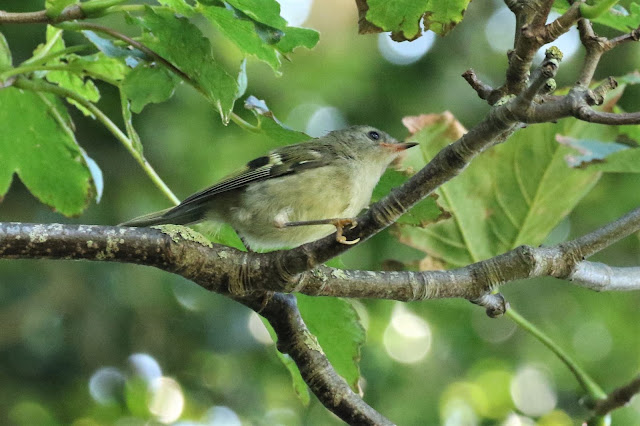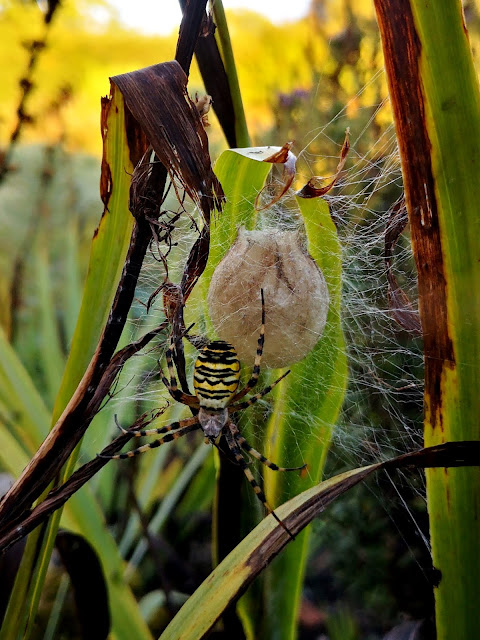Michael Holdsworth spoke at the ANW member's meeting earlier this year, about his very interesting
Spotted Flycatcher Project which, over the past few years, has aimed to understand more about the factors influencing the decline of this lovely migrant summer visitor.
He recently posted an update to this project on the Cambridgeshire Bird Ringing site. Further details can also be found here:
http://cambridgeshirebirdringing.org/spofl-menu/
Cambridgeshire Spotted Flycatcher geolocator project – 2019 update
Our geolocator project fieldwork is now complete. By the middle of August, when
this is being written, we are left with only a handful of second-brood or replacement
nests still active and feeding young. Most adults will have left. As usual, I haven’t
received more than one or two records from outside the project all summer, and I
don’t expect to receive any more now, so here’s a quick stock-take of our results for
the 2019 season.
The BTO geolocator project has been designed and managed by Chris Hewson.
We – mainly just Lee Barber (BTO) and I – have been working on a two-year cycle.
We attached geolocator tags for the first time (anywhere in Europe for the species)
on flycatchers in 2016, for retrieval in 2017. There is a parallel RSPB project in Devon.
The tags, 0.35gm and the size of a small button, do not transmit and cannot be read
remotely; so they have to be removed from the bird for the data to be downloaded.
We attached tags on a second cohort last year 2018, so this year was our second
retrieval year. The nature of our fieldwork is very much dictated by whether we are
tagging or retrieving; in a retrieval year like 2019 we find fewer nests and spend all
our time focussing on sites where we think our geolocator birds will be. It is thus
important to remember that this isn’t anything like a county-wide survey or census;
with just one exception we have no sites north of Ely, and we have none in the Fens.
We probably only find a fraction of the flycatchers out there, even though birders
never seem to record them at all.
This season we ringed 101 nestling and 32 new adult flycatchers. That total, 133, is
the same as in 2018 (94, 39). This excludes nestlings which died before fledging – for
which we had an exceptional number this year due to a spell of very wet and cold
weather in early June; we also lost at least two incubating females at that time.
Nationally, for Britain and Ireland, only 1,162 flycatchers were ringed in 2018. 742 of
these were full-grown birds mainly trapped on spring and autumn passage at
coastal bird observatories, and particularly at Portland and the Calf of Man. 420
were ringed as nestlings.
We had nineteen 2018 tags to retrieve, and we managed five. To do this, the birds
obviously first must survive their round-trip migration of about 26,000km; then we
2
have to locate them; and then we have to catch them. Not always straightforward:
one canny bird took us four site visits and over eight hours to re-catch. We had a
sixth bird which came back, was seen once and then vanished. Overall, six (32%) is a
reasonable return-rate. Of 89 identifiable adults in the project so far, we’ve re-found
35 (39%) surviving into a later year. This is of course a minimum figure, as some
birds will always survive without being re-found. In 2017 we had 9/19 come back
(seven tags retrieved), which at 47% was an exceptionally high proportion for a
small sub-Saharan migrant passerine. The tag data are providing unique insights
into migration timing, routes, stopovers, desert crossing strategies and wintering
areas – mainly in Angola.
There will still be some pairs to add, but we have this year provisionally confirmed
breeding in 49 out of 71 pairs in 50 tetrads (final count 65/80 in 66 in 2018). We know
of 44 nests in 30 tetrads (41 in 32).
Since the project started, we have ringed a total of 382 nestlings and 127 adults. None
of our adults has ever been encountered or recovered elsewhere. All our re-sighted
adults have returned to within a few hundred metres of where they were originally
ringed, except for one which moved 2.25km. If this happens regularly, then they
could be many more adults that we are missing. With most territories within 100m
of the nest, and often less, cold searching just isn’t an option.
We haven’t seen or heard of any of our 382 ringed nestlings again, which may be
confirming the theory that one of the principal causes of the species decline is that
survival of young birds in the first year after fledging is insufficient to recruit
enough replacements into the population to offset adult mortality.
We won’t be continuing with a BTO geolocator project into 2020; we now have
sufficient migration tracks to answer the main questions about routes, stopovers and
wintering areas. I myself, however, will continue to monitor our Cambridgeshire
birds as time permits next year.
My thanks this year to Geoff Barlow, Carole Davis, Rob McEwen and Bernard Siddle
for additional help with fieldwork.
Michael Holdsworth
15 August 2019
Please email spofl@cambridgebirdclub.org.uk with all Cambridgeshire Spotted Flycatcher records
from May to October. Thanks in advance.




























































